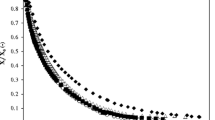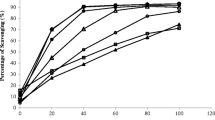Abstract
The purpose of this study was to determine the effects of convective air-drying at different temperatures (35, 50, 60 and 75 °C) on the colour and particle size distribution of Ascophyllum nodosum seaweed powders obtained after milling (mesh 500 μm). The antioxidant activity and polyphenolic and carbohydrate content of the aqueous extracts obtained by ultrasound-assisted extraction from air-dried and freeze-dried samples (−55 °C, 0.5 Pa) were also determined. Particle size characterization of the seaweed powders indicated that the highest mass fraction, for all drying temperatures, corresponded to a range of sizes of 250–500 μm. Significant differences of mean diameters of powder between samples dried below and above 50 °C were found (P ≤ 0.05). Ascophyllum nodosum seaweed powders exhibited a predominance of greenness and yellowness with differences between powders particle size obtained from A. nodosum dried at 35–50 °C (yellowish green) and 60–75 °C (brown). A study of the effect of drying temperature on polyphenolic content (TP), DPPH scavenging activity (SA) and carbohydrate content (CHO) of A. nodosum aqueous extracts obtained from all powders and freeze-dried samples showed a maximum TP (3180 mg PHL (100 g)−1 d.w.), SA (76.2%) and CHO (6465 mg GL (100 g)−1 d.w.) for samples dried at 50 °C. These values were higher than those measured for freeze-dried samples (1500 mg PHL (100 g)−1 d.w., 70.9% and 5136 mg GL (100 g)−1 d.w.). A relationship between SA of aqueous extracts and the colour of air-dried, milled A. nodosum was found. SA and CHO decreased with increasing air-drying temperature. The same trend with temperature was observed for aqueous extracts obtained only with the highest mass fraction, with lower values of TP, SA and CHO.



Similar content being viewed by others
References
Adekunte AO, Tiwari BK, Cullen PJ, Scannell AGM, O’Donnell CP (2010) Effect of sonication on colour, ascorbic acid and yeast inactivation in tomato juice. Food Chem 122:500–507
Bahar B, O’Doherty JV, Smyth TJ, Sweeney T (2016) A comparison of the effects of an Ascophyllum nodosum ethanol extract and its molecular weight fractions on the inflammatory immune gene expression in-vitro and ex-vivo. Innov Food Sci Emerg Technol 37:276–285
Barbot YN, Al-Ghaili H, Benz R (2016) A review on the valorization of macroalgal wastes for biomethane production. Mar Drugs 14:120–147
Bertness MD, Bruno JF, Silliman BR, Stachowicz JJ (2014) Marine community ecology and conservation. Sinauer Associates Inc, Sunderland
Brand-Williams W, Cuvelier ME, Berset C (1995) Use of a free radical method to evaluate antioxidant activity. LWT - Food Sci Technol 28:25–30
Brennan JG (1994) Food dehydration. A dictionary and guide, 1st edn. Woodhead Publishing, Cambridge
Cardoso SM, Pereira OR, Seca AML, Pinto DCGA, Silva AMS (2015) Seaweeds as preventive agents for cardiovascular diseases: from nutrients to functional foods. Mar Drugs 13:6838–6865
Chew YL, Lim YY, Omar M, Khoo KS (2008) Antioxidant activity of three edible seaweeds from two areas in South East Asia. LWT - Food Sci Technol 41:1067–1072
Corbin C, Fidel T, Leclerc EA, Barakzoy E, Sagot N, Falguiéres A, Renouard S, Blondeau JP, Ferroud C, Doussot J, Lainé E, Hano C (2015) Development and validation of an efficient ultrasound assisted extraction of phenolic compounds from flax (Linum usitatissimum L.) seeds. Ultrason Sonochem 26:176–185
Cornish ML, Garbary DJ (2010) Antioxidants from macroalgae: potential applications in human health and nutrition. Algae 25:155–171
Cruces E, Rojas-Lillo Y, Ramirez-Kushel E, Atala E, López-Alarcón C, Lissi E, Gómez I (2016) Comparison of different techniques for the preservation and extraction of phlorotannins in the kelp Lessonia spicata (Phaeophyceae): assays of DPPH, ORAC-PGR, and ORAC-FL as testing methods. J Appl Phycol 28:573–580
DuBois M, Gilles KA, Hamilton JK, Rebers PA, Smith F (1956) Colorimetric method for determination of sugars and related substances. Anal Chem 28:350–356
Fan D, Hodges DM, Zhang J, Kirby CW, Ji X, Locke SJ, Critchley AT, Prithiviraj B (2011) Commercial extract of the brown seaweed Ascophyllum nodosum enhances phenolic antioxidant content of spinach (Spinacia oleracea L.) which protects Caenorhabditis elegans against oxidative and thermal stress. Food Chem 124:195–202
Gupta S, Cox S, Abu-Ghannam N (2011) Effect of different drying temperatures on the moisture and phytochemical constituents of edible Irish brown seaweed. LWT - Food Sci Technol 44:1266–1272
Heo SJ, Park EJ, Lee KW, Jeon YJ (2005) Antioxidant activities of enzymatic extracts from brown seaweeds. Bioresour Technol 96:1613–1623
Holdt SL, Kraan S (2011) Bioactive compounds in seaweed: functional food applications and legislation. J Appl Phycol 23:543–597
Hosokawa M, Wanezaki S, Miyauchi K, Kunihara H, Kohno H, Kawabata J, Odashima S, Takahashi K (1999) Apoptosis-inducing effect of fucoxanthin on human leukemia cell line HL-60. Food Sci Technol Res 5:243–246
Kadam SU, Tiwari BK, Smyth TJ, O’Donnell CP (2015) Optimization of ultrasound assisted extraction of bioactive components from brown seaweed Ascophyllum nodosum using response surface methodology. Ultrason Sonochem 23:308–316
Khairy HM, El-Sheikh MA (2015) Antioxidant activity and mineral composition of three Mediterranean common seaweeds from Abu-Qir Bay. Egypt Saudi J Biol Sci 22:623–630
Kılınç B, Cirik S, Turan G, Tekogul G, Koru E (2013) Seaweeds for food and industrial applications. In: Muzzalupo I (ed) Food industry. InTech, Riejka, pp 735–748
Ling ALM, Yasir S, Matanjun P, Abu Bakar MF (2015) Effect of different drying techniques on the phytochemical content and antioxidant activity of Kappaphycus alvarezii. J Appl Phycol 27:1717–1723
Mason TJ, Chemat F, Vinatoru M (2011) The extraction of natural products using ultrasound or microwaves. Curr Org Chem 15:237–247
Matanjun P, Mohamed S, Mustapha NM, Muhammad K, Ming CH (2008) Antioxidant activities and phenolics content of eight species of seaweeds from north Borneo. J Appl Phycol 20:367–373
Mayor L, Sereno AM (2004) Modelling shrinkage during convective drying of food materials: a review. J Food Eng 61:373–386
McHugh DJ (2003) A guide to the seaweed industry. FAO, Rome
Moreira R, Chenlo F, Sineiro J, Arufe S, Sexto S (2016) Drying temperature effect on powder physical properties and aqueous extract characteristics of Fucus vesiculosus. J Appl Phycol 28:2485–2494
Mujumdar AS (2006) Handbook of industrial drying, 3rd edn. CRC Press, Boca Raton
Norra I, Aminah A, Suri R (2016) Effects of drying methods, solvent extraction and particle size of Malaysian brown seaweed, Sargassum sp. on the total phenolic and free radical scavenging activity. Int Food Res J 23:1558–1563
Pádua D, Rocha E, Gargiulo D, Ramos AA (2015) Bioactive compounds from brown seaweeds: phloroglucinol, fucoxanthin and fucoidan as promising therapeutic agents against breast cancer. Phytochem Lett 14:91–98
Peinado I, Girón J, Koutsidis G, Ames JM (2014) Chemical composition, antioxidant activity and sensory evaluation of five different species of brown edible seaweeds. Food Res Int 66:36–44
Rodrigues D, Sousa S, Silva A, Amorim M, Pereira L, Rocha-Santos TAP, Gomes AMP, Duarte AC, Freitas AC (2015) Impact of enzyme- and ultrasound-assisted extraction methods on biological properties of red, brown, and green seaweeds from the central west coast of Portugal. J Agric Food Chem 63:3177–3188
Rupérez P (2002) Mineral content of edible marine seaweeds. Food Chem 79:23–26
Santchurn SJ, Arnaud E, Zakhia-Rozis N, Collignan A (2012) Drying: principles and applications. In: Huy YH (ed) Handb. Meat meat process, 2nd edn. CRC Press, Boca Raton, p 506
Singleton VL, Rossi JA (1965) Colorimetry of total phenolics with phosphomolybdic-phosphotungstic acid reagents. Am J Enol Vitic 16:144–158
Stengel DB, Dring MJ (1998) Seasonal variation in the pigment content and photosynthesis of different thallus regions of Ascophyllum nodosum (Fucales, Phaeophyta) in relation to position in the canopy. Phycologia 37:259–268
Stengel DB, Connan S, Popper ZA (2011) Algal chemodiversity and bioactivity: sources of natural variability and implications for commercial application. Biotechnol Adv 29:483–501
Symons GE, Morey B (1941) The effect of drying time on the determination of solids in sewage and sewage sludges. Sew Work J 13:936–939
Talmaciu AI, Volf I, Popa VI (2015) A comparative analysis of the “green” techniques applied for polyphenols extraction from bioresources. Chem Biodivers 12:1635–1651
Tariq A, Athar M, Ara J, Sultana V, Ehteshamul-Haque S, Ahmad M (2015) Biochemical evaluation of antioxidant activity and polysaccharides fractions in seaweeds. Glob J Environ Sci Manag 1:47–62
Tello-Ireland C, Lemus-Mondaca R, Vega-Gálvez A, López J, Di Scala K (2011) Influence of hot-air temperature on drying kinetics, functional properties, colour, phycobiliproteins, antioxidant capacity, texture and agar yield of alga Gracilaria chilensis. LWT - Food Sci Technol 44:2112–2118
Werner A, Kraan S (2004) Review of the potential mechanisation of kelp harvesting in Ireland. Marine Environment and Health Series No. 17, Marin Institute
Xu C, Leskovar DI (2015) Effects of A. nodosum seaweed extracts on spinach growth, physiology and nutrition value under drought stress. Sci Hortic 183:39–47
Yuan Y, Macquarrie D (2015) Microwave assisted extraction of sulfated polysaccharides (fucoidan) from Ascophyllum nodosum and its antioxidant activity. Carbohydr Polym 129:101–107
Acknowledgements
The authors acknowledge the financial support of the Ministry of Economy and Competitiveness of Spain and European Regional Development Fund (ERDF) of European Union by the research project (CTQ 2013-43616/P).
Author information
Authors and Affiliations
Corresponding author
Rights and permissions
About this article
Cite this article
Moreira, R., Sineiro, J., Chenlo, F. et al. Aqueous extracts of Ascophyllum nodosum obtained by ultrasound-assisted extraction: effects of drying temperature of seaweed on the properties of extracts. J Appl Phycol 29, 3191–3200 (2017). https://doi.org/10.1007/s10811-017-1159-6
Received:
Revised:
Accepted:
Published:
Issue Date:
DOI: https://doi.org/10.1007/s10811-017-1159-6




